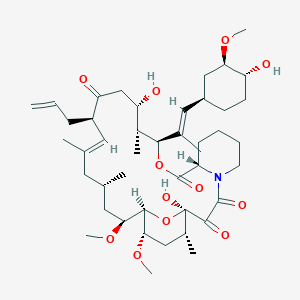Prophylaxis of cardiac graft rejection
Adult: Initially, 10-20 mcg/kg daily by continuous 24-hr infusion for up to 7 days.
Child: W/o antibody induction: Initially, 30-50 mcg/kg daily by continuous 24-hr infusion. Start 1st oral dose 8-12 hr after stopping infusion at a dose of 300 mcg/kg daily in 2 divided doses.
Child: W/o antibody induction: Initially, 30-50 mcg/kg daily by continuous 24-hr infusion. Start 1st oral dose 8-12 hr after stopping infusion at a dose of 300 mcg/kg daily in 2 divided doses.
Intravenous
Prophylaxis of rejection in liver graft transplant
Adult: Initially, 10-50 mcg/kg daily by continuous 24-hr infusion for up to 7 days.
Child: 50 mcg/kg daily by continuous 24-hr infusion for up to 7 days. Convert to oral therapy as soon as clinically tolerated.
Child: 50 mcg/kg daily by continuous 24-hr infusion for up to 7 days. Convert to oral therapy as soon as clinically tolerated.
Intravenous
Prophylaxis of rejection in kidney graft transplant
Adult: Initially, 50-100 mcg/kg daily by continuous 24-hr infusion for up to 7 days.
Child: 75-100 mcg/kg daily by continuous 24-hr infusion for up to 7 days. Convert to oral therapy as soon as clinically tolerated.
Child: 75-100 mcg/kg daily by continuous 24-hr infusion for up to 7 days. Convert to oral therapy as soon as clinically tolerated.
Oral
Prophylaxis of rejection in kidney graft transplant
Adult: Initially, 200-300 mcg/kg daily, given in 2 divided doses (immediate-release) or once daily (extended-release). Start w/in 24 hr after transplant.
Child: As immediate-release tab/cap: Initially, 300 mcg/kg daily in 2 divided doses. Start w/in 24 hr after transplant. Adolescents: 200 mcg/kg daily.
Child: As immediate-release tab/cap: Initially, 300 mcg/kg daily in 2 divided doses. Start w/in 24 hr after transplant. Adolescents: 200 mcg/kg daily.
Oral
Treatment for rejection of pancreas transplant
Adult: In patient resistant to conventional immunosuppressive agents: Initially, 200 mcg/kg daily, given in 2 divided doses (immediate-release) or once daily (extended-release).
Oral
Treatment of lung transplant rejection
Adult: In patient resistant to conventional immunosuppressive agents: Initially, 100-150 mcg/kg daily, given in 2 divided doses (immediate-release) or once daily (extended-release).
Oral
Treatment of liver transplant rejection
Adult: In patient resistant to conventional immunosuppressive agents: Initially, 100-200 mcg/kg daily, given in 2 divided doses (immediate-release) or once daily (extended-release).
Child: In patient resistant to conventional immunosuppressive agents: As immediate-release tab/cap: Initially, 300 mcg/kg daily in 2 divided doses.
Child: In patient resistant to conventional immunosuppressive agents: As immediate-release tab/cap: Initially, 300 mcg/kg daily in 2 divided doses.
Oral
Treatment of cardiac transplant rejection
Adult: In patient resistant to conventional immunosuppressive agents: Initially, 150 mcg/kg daily, given in 2 divided doses (immediate-release) or once daily (extended-release).
Child: In patient resistant to conventional immunosuppressive agents: As immediate-release tab/cap: Initially, 200-300 mcg/kg daily in 2 divided doses.
Child: In patient resistant to conventional immunosuppressive agents: As immediate-release tab/cap: Initially, 200-300 mcg/kg daily in 2 divided doses.
Oral
Prophylaxis of rejection in liver graft transplant
Adult: Initially, 100-200 mcg/kg daily, given in 2 divided doses (immediate-release) or once daily (extended-release). Start w/in 12 hr after transplant.
Child: As immediate-release tab/cap: Initially, 300 mcg/kg daily in 2 divided doses. Start approx 12 hr after transplant.
Child: As immediate-release tab/cap: Initially, 300 mcg/kg daily in 2 divided doses. Start approx 12 hr after transplant.
Oral
Treatment of kidney transplant rejection
Adult: In patient resistant to conventional immunosuppressive agents: Initially, 200-300 mcg/kg daily, given in 2 divided doses (immediate-release) or once daily (extended-release).
Child: In patient resistant to conventional immunosuppressive agents: As immediate-release tab/cap: Initially, 300 mcg/kg daily in 2 divided doses.
Child: In patient resistant to conventional immunosuppressive agents: As immediate-release tab/cap: Initially, 300 mcg/kg daily in 2 divided doses.
Oral
Prophylaxis of cardiac graft rejection
Adult: Initially, 75 mcg/kg daily, after antibody induction w/in 5 days after transplant and when patient is stable, given in 2 divided doses (immediate-release) or once daily (extended-release).
Child: As immediate-release tab/cap: Initially, 100-300 mcg/kg daily in 2 divided doses after antibody induction. Start w/in 5 days after transplant and when patient is stable.
Child: As immediate-release tab/cap: Initially, 100-300 mcg/kg daily in 2 divided doses after antibody induction. Start w/in 5 days after transplant and when patient is stable.
Oral
Treatment for rejection of intestine transplant
Adult: In patient resistant to conventional immunosuppressive agents: Initially, 300 mcg/kg daily, given in 2 divided doses (immediate-release) or once daily (extended-release).
Topical/Cutaneous
Atopic dermatitis
Adult: As 0.03% or 0.1% oint: Apply thinly to affected area(s) bid. If no improvement after 2 wk, consider further treatment options. Maintenance: As 0.1% oint: Apply thinly to affected area(s) twice wkly w/ 2-3 days between applications for up to 12 mth in patient who responded to up to 6 wk of bid treatment.
Child: 2-16 yr As 0.03% oint: Apply thinly to affected area(s) bid for up to 3 wk. Maintenance: Apply thinly to affected area(s) twice wkly w/ 2-3 days between applications for up to 12 mth in patient who responded to up to 6 wk of initial treatment.
Child: 2-16 yr As 0.03% oint: Apply thinly to affected area(s) bid for up to 3 wk. Maintenance: Apply thinly to affected area(s) twice wkly w/ 2-3 days between applications for up to 12 mth in patient who responded to up to 6 wk of initial treatment.




 Đăng xuất
Đăng xuất


